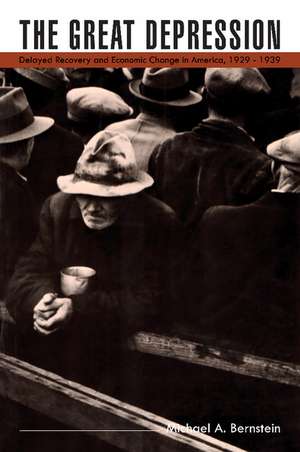The Great Depression: Delayed Recovery and Economic Change in America, 1929–1939: Studies in Economic History and Policy: USA in the Twentieth Century
Autor Michael A. Bernsteinen Limba Engleză Paperback – 26 ian 1989
Preț: 205.03 lei
Nou
Puncte Express: 308
Preț estimativ în valută:
39.24€ • 42.64$ • 32.99£
39.24€ • 42.64$ • 32.99£
Carte tipărită la comandă
Livrare economică 21 aprilie-05 mai
Preluare comenzi: 021 569.72.76
Specificații
ISBN-13: 9780521379854
ISBN-10: 0521379857
Pagini: 288
Ilustrații: illustrations
Dimensiuni: 152 x 229 x 15 mm
Greutate: 0.4 kg
Ediția:Revised
Editura: Cambridge University Press
Colecția Cambridge University Press
Seria Studies in Economic History and Policy: USA in the Twentieth Century
Locul publicării:New York, United States
ISBN-10: 0521379857
Pagini: 288
Ilustrații: illustrations
Dimensiuni: 152 x 229 x 15 mm
Greutate: 0.4 kg
Ediția:Revised
Editura: Cambridge University Press
Colecția Cambridge University Press
Seria Studies in Economic History and Policy: USA in the Twentieth Century
Locul publicării:New York, United States
Cuprins
List of tables; List of figures; Editors' preface; Preface; Introduction: the puzzle of the 1930s; 1. Long-term economic growth and the problem of recovery in the United States, 1929–39; 2. The transformation of American industry in the interwar period; 3. A reassessment of investment failure in the interwar economy; 4. Technical change during the interwar years; 5. The effective demand problem of the interwar period I: cyclical and structural unemployment; 6. The effective demand problem of the interwar period II: cyclical and secular changes in final demand; 7. New deal economic policy and the problem of recovery; 8. Contemporary economic problems in historical perspective; Bibliography; Index.
Recenzii
'Bernstein focuses on the real puzzle of the 1930s: why did the economy fail to recover from the downturn of 1929–1933? he presents a convincing case that there were important long-run tendencies within the economy that are crucial to understanding this failure. His approach cuts across the more traditional explanations which have been for the most part tests of economic theories rather than historical explanations of the depression. Bernstein's book is, in a word, impressive.' Roger Ransom, University of California, Riverside
'This book makes an excellent case for the argument that sectoral transformation was an important contributing factor to the length of the Great Depression. It also points out the importance of including sectoral change in all economic histories of the twentieth century.' John Joseph Wallis, Journal of Economic History
'Michael Bernstein changes the nature of the recent debate about the aftermath of the great Depression. Instead of the familiar but now sterile arguments about macroeconomic aggregates, Bernstein forces us to consider long-term secular change. From a wealth of detail about individual industries emerges a bold thesis about the interwar economy. His work is ambitious and substantial. His arguments represent a major challenge to received wisdom. No small achievement.' Michael Weinstein, Reviews in American History
'By emphasizing both cyclical and secular factors and by showing that some sectors of the economy demonstrated technological dynamism during the 1930s, this book performs a valuable service.' Peter Fearon, Economic History Review
'This book makes an excellent case for the argument that sectoral transformation was an important contributing factor to the length of the Great Depression. It also points out the importance of including sectoral change in all economic histories of the twentieth century.' John Joseph Wallis, Journal of Economic History
'Michael Bernstein changes the nature of the recent debate about the aftermath of the great Depression. Instead of the familiar but now sterile arguments about macroeconomic aggregates, Bernstein forces us to consider long-term secular change. From a wealth of detail about individual industries emerges a bold thesis about the interwar economy. His work is ambitious and substantial. His arguments represent a major challenge to received wisdom. No small achievement.' Michael Weinstein, Reviews in American History
'By emphasizing both cyclical and secular factors and by showing that some sectors of the economy demonstrated technological dynamism during the 1930s, this book performs a valuable service.' Peter Fearon, Economic History Review
Descriere
This 1988 book focusses on why the American economy failed to recover from the downturn of 1929–33.
































